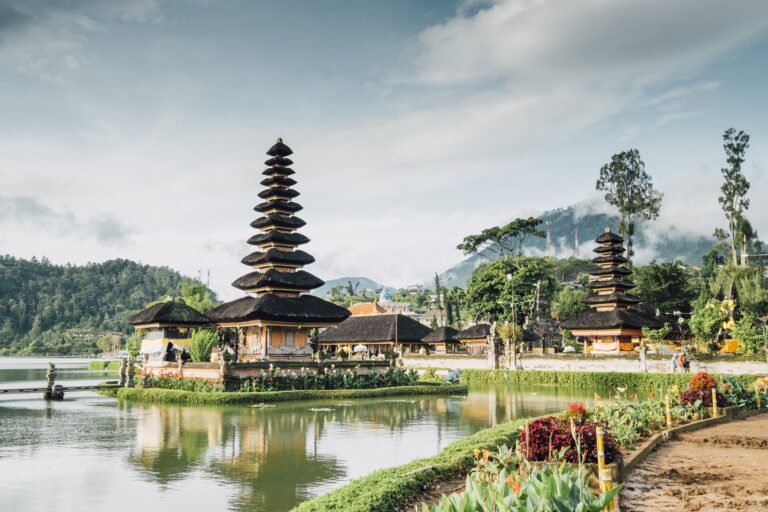Bali, a true gem of Indonesia, invites you with its beautiful nature, rich culture, and tranquil spirituality. Whether you love beaches, seek adventure, appreciate culture, or simply yearn for peace, Bali has something special for everyone. In this guide, we’ll explore the top experiences to make sure your journey through the islands is unforgettable and helps you plan an amazing Bali itinerary.
Table of Contents
UBUD
Ubud sits at the heart of Bali, away from the busy beaches, about 35 kilometers (22 miles) north of Ngurah Rai International Airport. It’s a must-visit destination for various reasons. Begin your journey at the Tegallalang Rice Terraces, known for their breathtaking green landscapes and traditional rice farming methods. Then explore the Sacred Monkey Forest Sanctuary, a jungle haven for long-tailed macaques, surrounded by ancient temple ruins.
Considered Bali’s cultural epicenter, Ubud boasts numerous art galleries, museums, and traditional workshops. It provides an immersive experience of Balinese culture, featuring everything from traditional dance performances to vibrant art markets. Ubud is a unique blend of natural beauty and cultural richness that shouldn’t be missed.

Ubud is surrounded by Balinese art villages, known for its unique craft. Whether it’s Celuk for silver and goldsmithing, Mas for wood carving, or Batuan for traditional painting. Visiting these villages offers a glimpse into Bali’s vibrant artistic legacy, where skills are intricately passed down through generations. Local artisans showcase their creations, and bargaining with a smile is all part of the fun shopping experience!
Ubud is now a world-famous destination for wellness and spiritual retreats. With numerous yoga studios, wellness centers, and holistic spas, the town offers a peaceful setting for self-discovery and relaxation, catering to both seasoned yogis and wellness enthusiasts.
Ubud has a wide range of tasty food options for everyone. Whether you prefer traditional local dishes from small eateries or international cuisine from fancy restaurants, Ubud has something to satisfy your taste buds. The focus on using fresh, local ingredients means you can enjoy a variety of delicious meals with a farm-to-table touch.
Ubud caters to various budgets and preferences, offering accommodations from luxurious resorts in nature to cozy guesthouses in town. The community vibe is strong, making it easy to connect with locals, expats, and fellow tourists through cultural events or coworking spaces. Plus, day trips to nearby attractions like Tegallalang Rice Terraces, Goa Gajah, and the Monkey Forest are conveniently accessible from Ubud, making it a great base for adventures.
Cons to visit Ubud:
Tourist Crowds: Ubud has become really popular, with lots of tourists, especially during busy times. This can make the central area crowded, taking away from the peaceful vibe that many people are looking for.
Traffic and Infrastructure: Ubud’s narrow streets can get really crowded, especially when it’s busy. Also, the infrastructure might not be as good as in bigger cities, causing some occasional inconveniences.
Commercialization: As more tourists visit, some areas in Ubud have become more commercial. This brings more facilities, but it has also changed the village’s traditional charm for some.
Higher Prices: Services and accommodation in Ubud are in high demand, causing prices to rise. As a result, certain parts of your trip might be pricier compared to other places in Bali.
Limited Nightlife: While Ubud is perfect for a tranquil and calm ambiance, those in search of lively nightlife might discover fewer choices. The village tends to quiet down early compared to livelier party destinations.
Weather: Ubud, being in the central highlands, tends to get more rain than the coast, especially in the wet season. So, be ready for some occasional rain showers.
CANGGU
Canggu is a cool coastal village in Bali, located between Seminyak and Tanah Lot. It’s famous for awesome surf spots, especially at Echo Beach. Whether you’re a pro or just starting, the consistent waves make it a perfect place to surf or take lessons. It’s becoming a popular spot for surf lovers!
Canggu’s beaches stand out because of their unique black volcanic sand, which attracts surfers and sun lovers alike. Echo Beach, a popular spot, is renowned for its top-notch surfing, stunning sunsets, and a mix of cozy cafes and bars right by the shore.
Canggu is a food lover’s paradise! It’s bursting with cool cafes, seaside bars, and trendy beach clubs. Whether you’re into wholesome smoothie bowls or global flavors, there’s something for everyone. The dining scene here is a feast for diverse tastes!
Bali’s wellness tourism is booming, attracting people seeking a complete travel experience centered on fitness and well-being. The active lifestyle embraced by both locals and expats has driven the demand for diverse fitness facilities, especially in Canggu. Here, gyms provide a range of options like weightlifting, CrossFit, yoga, and pilates, catering to various preferences. Canggu’s natural beauty, including beaches and lush landscapes, adds to the allure of fitness activities. Gyms often leverage these surroundings, offering open-air spaces with panoramic views for an enhanced fitness experience.
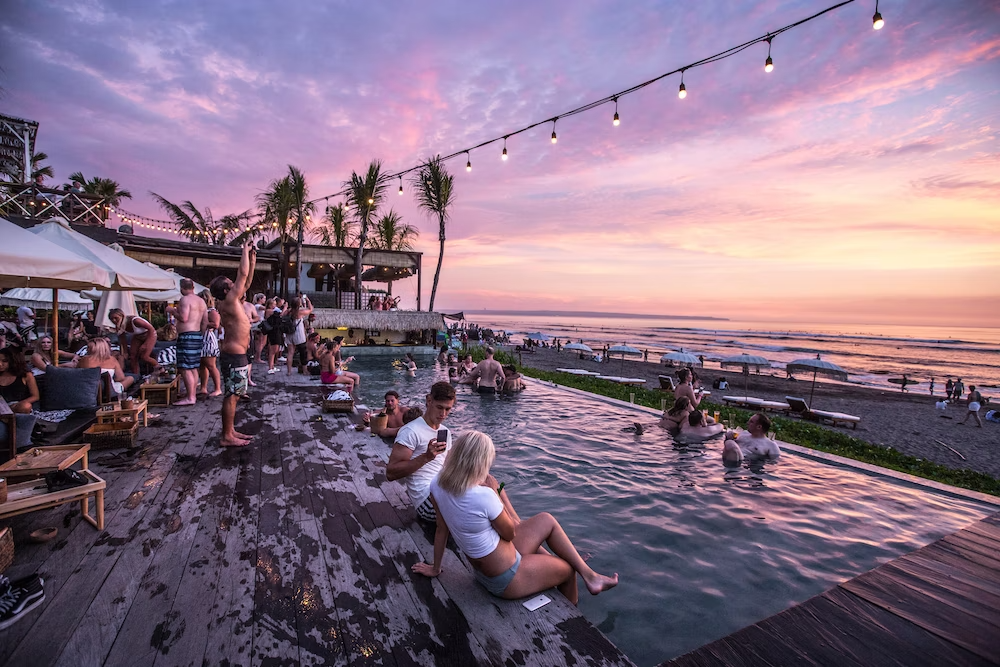

Canggu provides a perfect mix of work and play, making it a hotspot for digital nomads. The community is diverse and welcoming, fostering a supportive atmosphere for remote workers. With numerous cozy cafes and coworking spots equipped with modern amenities, free Wi-Fi, and a laid-back vibe, it’s an ideal place for digital nomads to work while soaking in the island’s charm.
At the same time, Canggu is known for its vibrant nightlife. You can sip a cocktail by the beach at popular spots like The Lawn, Finns Beach Club, or Old Man’s while enjoying the sunset. These places often throw live music events, themed parties, and DJ sets. On weekends and special occasions, you might catch themed events and parties. What sets Canggu’s nightlife apart is its easygoing and relaxed vibe. It’s a perfect place to chill with friends or make new ones, offering a laid-back atmosphere with occasional bursts of lively entertainment.
Cons to visit Canggu:
Increasing Tourism: The popularity of Canggu has led to increased tourism, potentially resulting in crowded beaches and a more bustling, particularly during peak seasons.
Traffic Congestion: Like other tourist hotspots, often has traffic jams, especially on narrow roads. So, be prepared for possible delays when navigating, especially during busy times.
Seasonal Weather Challenges: Just like the rest of Bali, Canggu has different seasons with varying weather. During the wet season, there are monsoons and heavy rains that can affect outdoor plans and limit beach enjoyment.
Limited Historical Sites: Canggu is famous for its stunning nature and modern vibe. If you’re into history or ancient sites, you might need to explore other areas in Bali.
Varied Accommodation Quality: In Canggu, there are many places to stay, but their quality can differ. Make sure to research and pick your accommodation wisely for a comfy experience.
Environmental Concerns: Canggu’s growing development and tourism are causing environmental worries. Problems like handling waste and affecting local ecosystems are becoming apparent, highlighting the need for responsible tourism practices.
Limited Public Transportation: Canggu might not have reliable public transportation like bigger cities do. You might need to rent a car or take taxis to get around easily.
Development Impact: Canggu’s fast growth and business expansion might change its unique charm. Some folks may opt for quieter, less built-up spots to enjoy a more genuine Bali experience.
Exploring Canggu is like embarking on a unique journey that goes beyond the usual tourist stuff. Whether you’re into beaches, beach clubs, or just living a balanced life, Canggu offers a varied and unforgettable adventure on Bali’s southwest coast. Just keep in mind to consider what you like and expect from your travels, as everyone has different preferences.
KUTA & SEMINYAK
Kuta and Seminyak are next-door coastal spots on Bali’s southwest coast, each with its own vibe. Kuta and Seminyak has a famous long, sandy beach that’s perfect for surfing, sunbathing, and beach fun. Surfers of all levels love the waves, and there’s plenty of space to chill on the sandy shores. It’s a great stunning sunsets over the Indian Ocean. Seminyak and Kuta offer different but equally appealing Kuta is a lively shopping and entertainment center. Walk along Jalan Legian and Kuta Square to discover a range of shops, from traditional markets to modern malls. Kuta, a shopping paradise in Bali, features beachside malls like Beachwalk, Lippo Mall, and Discovery Mall. These spots offer a variety of goods, from local crafts to international brands, and even cinemas for your entertainment.
Kuta’s nightlife is famous for its vibrant atmosphere, featuring lots of bars, clubs, and beachside spots that offer a variety of entertainment. The streets buzz with the sounds of street vendors, and you can enjoy live music until the early morning hours every day.
Although Kuta is famous for its vibrant ambiance, it also offers chances to immerse yourself in Balinese culture. Enjoy traditional dance shows, visit local temples, and connect with the welcoming Balinese locals.
Kuta is a great hub to start your Bali adventures because it’s centrally located and close to the airport. You can easily explore other parts of Bali, like Canggu, Denpasar, Sanur, and Jimbaran, on day trips from here.
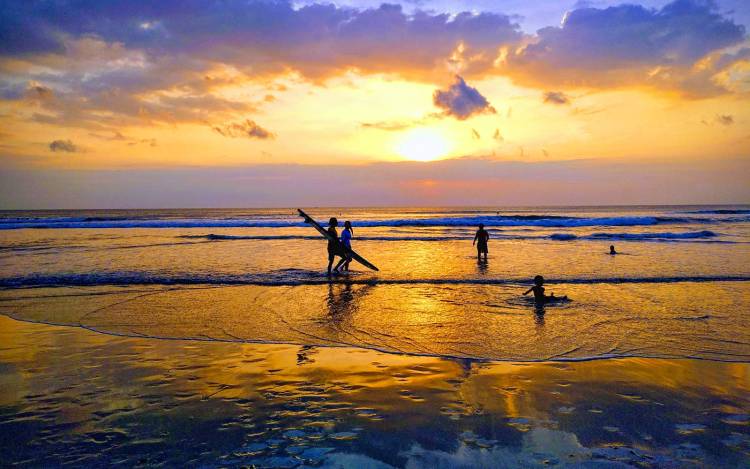
Seminyak, just north of Kuta, has a fancier vibe with upscale resorts, trendy boutique hotels, and luxurious villas. It’s a go-to for those who prefer a more refined experience. If you’re into fashion and unique design, Seminyak’s got you covered with chic boutiques featuring local and international designers. It’s a shopping haven for those who love quality craftsmanship and stylish trends.

Seminyak’s streets offer a variety of dining choices, from seaside seafood spots and stylish cafes to high-end fine-dining venues. Whether you’re into local or international flavors, Seminyak has something for every taste.
Seminyak has some of Bali’s top beach spots like Mari Beach Club, Ku De Ta, Potato Head Beach Club, Sugarsand, and Cocoon Day Club. These places give you a fancy beach vibe with cool infinity pools, comfy daybeds, and lively music. The beach is famous for its stunning sunsets, attracts crowds to enjoy the sky turning shades of orange and pink.
Take time for yourself in Seminyak by making wellness a top priority. Treat yourself to soothing spa sessions, rejuvenating yoga classes, and holistic therapies. With an abundance of spas and wellness retreats, Seminyak offers a tranquil retreat away from the busy city life.
Cons to visit Kuta and Seminyak:
Kuta:
-
Crowds and Commercialization: Kuta Beach is really famous, so it tends to get super crowded, especially when lots of tourists are around. If you’re looking for a quieter and more peaceful beach vibe, Kuta might not be the best choice. It’s become really commercialized, with tons of shops, restaurants, and activities geared towards tourists, and some people feel it’s lost that authentic Balinese charm.
-
Nightlife Noise: If you’re looking for a quiet night’s sleep, be aware that Kuta’s vibrant nightlife, with its bars, clubs, and street activities, might be a bit too lively for your taste.
Seminyak:
-
Higher Prices: Seminyak is known for being more expensive than Kuta, with higher prices for hotels, restaurants, and shopping. It might not be the ideal destination for budget travelers.
-
Tourist density and Overwhelming Development: Seminyak is really popular, so lots of tourists go there. Because of that, the beaches, restaurants, and attractions can get pretty crowded, which might not be great if you like quiet places. Also, Seminyak has grown really fast and become more city-like, so it’s not as naturally charming as it used to be.
General Consideration to visit Kuta Seminyak:
-
Traffic Congestion: Getting around in Kuta and Seminyak can be tricky, especially during busy times. Traffic jams are common, and finding parking can be a bit of a hassle.
-
Hawkers and Touts: Kuta and Seminyak beaches and the nearby areas often have many street vendors and sellers offering different things. Some people like the lively vibe, but others might feel bothered by the constant sales pitches.
-
Limited Cultural Immersion: Because Kuta and Seminyak are popular tourist destinations, you might find fewer chances to experience the authentic local culture compared to traditional Balinese villages.
-
Environmental Impact: The high volume of tourists in Kuta and Seminyak has led to environmental challenges, including issues related to waste management and pollution.
-
Lack of Serenity: Kuta and Seminyak are vibrant and busy, which might be too much for those wanting a calm getaway. The non-stop hustle may be a bit too intense for those seeking a quieter setting.
-
Limited Nature Activities: Kuta and Seminyak lack green landscapes and outdoor activities. For nature lovers, Bali offers better options with lush scenery, rice terraces, and hiking trails in other regions.
Keep in mind that everyone’s experience is different. What might bother one person may not bother another. Even though there are some downsides, many people really enjoy the lively atmosphere, diverse attractions, and beautiful scenery in Kuta and Seminyak.
JIMBARAN
Situated on Bali’s southwest coast, Jimbaran started as a fishing village and has now become a popular tourist spot. With beautiful beaches, delicious seafood, and a peaceful atmosphere, Jimbaran combines natural beauty with cultural charm.
Jimbaran has golden sandy beaches that stretch along the azure waters of the Indian Ocean. The calm and gentle waves make it an ideal location for swimming, sunbathing, and enjoying leisurely walks along the shore. Despite its popularity among tourists, Jimbaran has managed to retain its traditional charm. Walking through the village, you’ll witness local fishermen tending to their boats and fixing nets, offering an authentic Bali’s maritime traditions. The village also hosts traditional ceremonies and performances, providing a wonderful opportunity to experience Bali’s rich cultural heritage.
Jimbaran is well-known for its fantastic seafood dining experience. Along the beach, you’ll find many restaurants setting up tables on the sand in the evening. They serve delicious, freshly caught seafood, allowing you to enjoy a great meal while witnessing one of Bali’s most breathtaking sunsets.
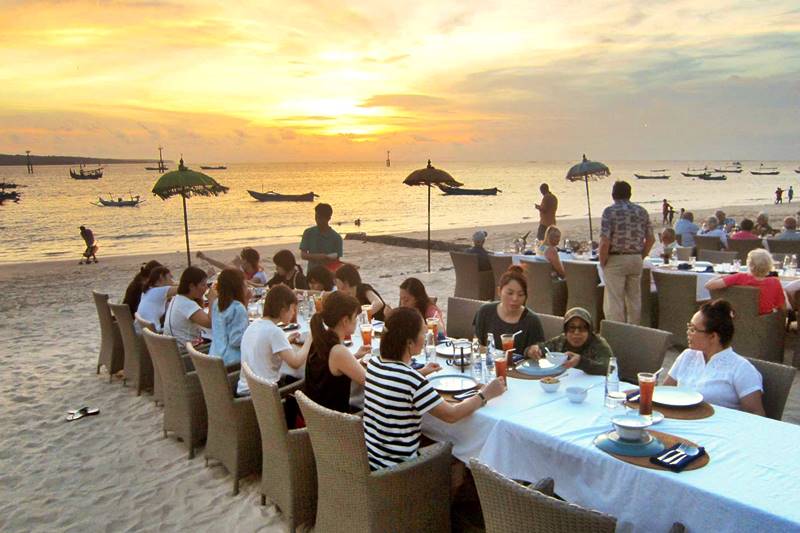
In addition to its famous seafood, Jimbaran has a variety of delicious dining options. Explore small local eateries called warungs for authentic Balinese cuisine, offering a well-rounded culinary experience beyond the popular seafood feasts.

Jimbaran is not really famous for shopping compared to some other places on the island. However, you can still enjoy distinctive shopping experiences there. Check out local markets for traditional Balinese crafts and souvenirs. Bargaining is a norm, so don’t hesitate to negotiate prices. Jimbaran Corner, a shopping complex, and beachside boutiques/stalls are also options for beachwear, sarongs, hats, and accessories. It’s a handy spot to shop if you’re spending the day by the beach.
Jimbaran is home to lavish resorts and spas, perfect for a peaceful and upscale retreat. You can enjoy top-notch facilities like infinity pools, spa treatments, and breathtaking ocean views. It’s an ideal spot for travelers seeking a bit of luxury and relaxation.
Cons to visit Jimbaran:
Limited Shopping Options: If you really want to do a lot of shopping during your trip, Jimbaran might not be the best choice. Although there are some local markets and boutiques, it doesn’t offer as much variety in shopping compared to places like Seminyak or Ubud.
Nightlife is Limited: Jimbaran is more laid-back when it comes to nightlife compared to places like Seminyak or Kuta. If you’re looking for lively bars and clubs, Jimbaran might not be the liveliest choice in the evenings.
Fewer Cultural Attractions: While Jimbaran is known for its laid-back local vibe, it doesn’t have as many cultural attractions as places like Ubud. If you’re keen on exploring temples, museums, and cultural performances, you might find other areas on the island more fitting for your interests.
Traffic Congestion: Like other popular tourist spots, Jimbaran in Bali can get pretty crowded with traffic, especially when lots of tourists are around. The roads to and from Jimbaran tend to be busy, especially during peak times for visitors.
Limited Budget Accommodations: Jimbaran is famous for its fancy resorts and villas. If you’re on a budget, though, there aren’t as many wallet-friendly places to stay compared to other parts of the island.
Tourist Crowds: Jimbaran is a popular tourist spot, especially the beach at sunset, which can get really busy. If you like peaceful places, some areas in Jimbaran might be a bit crowded with tourists.
Less Diverse Culinary Scene: While Jimbaran is known for its beachside seafood dining, the variety of food options there might not be as extensive as in places like Kuta-Seminyak. If you’re a food lover seeking a diverse culinary experience, you might want to check out other dining hotspots on the island.
Even with these things to think about, lots of people still think Jimbaran is a charming and relaxing place. If you want more shopping, adventures, and more lively options, check out nearby places like Kuta, Seminyak, or Ubud for a wider variety.
ULUWATU & UNGASAN
Uluwatu and Ungasan are two separate places in Bali, each with its own special features. Uluwatu is around the Uluwatu Temple on the southwest tip of the Bukit Peninsula. On the other hand, Ungasan is a larger area on the Bukit Peninsula, next to Uluwatu but covering a wider area.
Uluwatu in Bali is an absolutely stunning coastal spot down south. It’s famous for its breathtaking cliffs, amazing ocean views, and cultural importance. The tall limestone cliffs provide an incredible panoramic look at the Indian Ocean. Whether you’re at the cliffs or Uluwatu Temple, you get jaw-dropping views of the deep blue sea, crashing waves, and the far-off horizon. The cliffs are so high that they make the whole scene feel majestic. And when the sun sets, the sky’s changing colors over the Indian Ocean make it a magical and romantic experience.
Uluwatu is a top-notch surfing spot in Bali, famous for its challenging waves at Uluwatu Surf Point. Surfers worldwide come here for the powerful waves, making it ideal for experienced surfers.


Uluwatu is surrounded by amazing beaches, and Suluban Beach, also called Blue Point Beach, is a hidden treasure beneath the cliffs. You can reach it through a cool cave entrance. The beach has golden sand, clear water, and cool rock formations. Another beach, Padang Padang Beach (Labuan Sait Beach), is famous for its stunning coral reefs and clear waters. It even starred in the movie “Eat, Pray, Love.” Bingin Beach is a lovely spot with a laid-back vibe and awesome waves. You’ll find cozy places to stay, cool cafes, and surf spots along the shore. Plus, there are more beautiful beaches nearby!
Uluwatu Temple is a special Balinese sea temple on a high cliff, 70 meters above the sea. It’s dedicated to sea spirits and is one of Bali’s main spiritual temples. The stunning location offers amazing views, especially at sunset, making it a popular spot for exploring and taking photos. During sunset at the temple’s amphitheater, you can watch the famous Kecak dance, a lively performance telling the Hindu epic, Ramayana, with rhythmic chanting and dramatic movements by a group of male dancers.
Uluwatu offers fancy resorts and private villas with amazing ocean views. Staying there gives you a peaceful and exclusive experience. Uluwatu offers fancy resorts and private villas with amazing ocean views. It’s a quiet and exclusive place to stay. While it’s not a big shopping spot like other places in Bali, you can find some local boutiques with clothes, accessories, and beach gear. Some shops also have cool surf stuff, fitting the area’s surfing vibe.
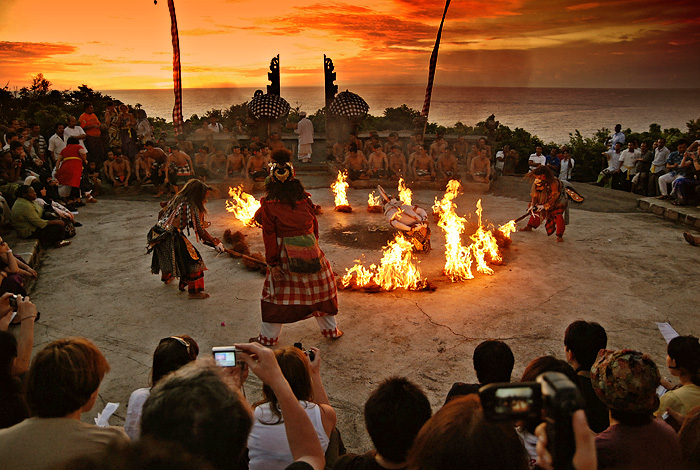
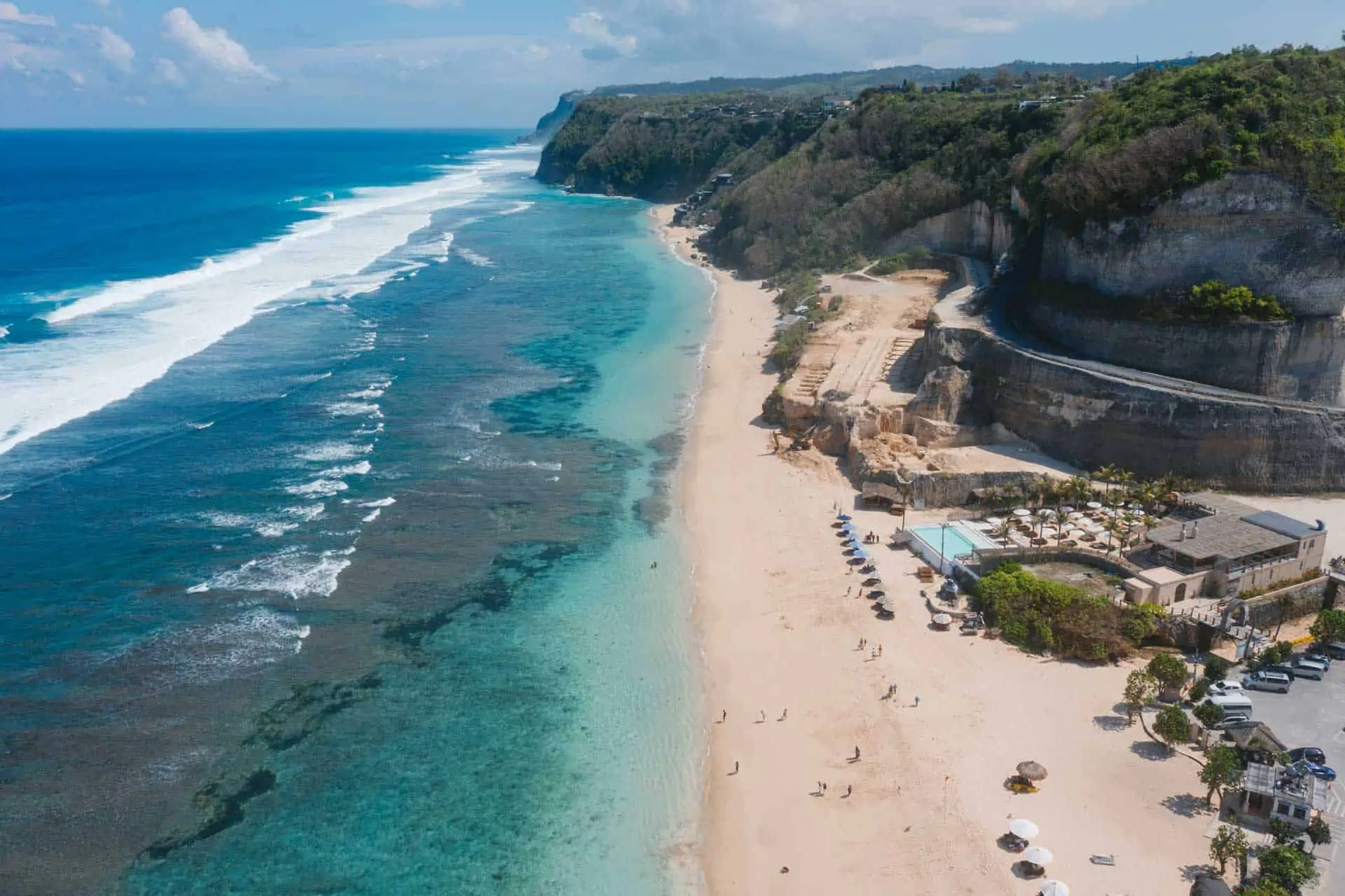
Ungasan is right next to Uluwatu, making it easy to explore both places effortlessly. Ungasan has beautiful, quiet beaches like Melasti Beach and Green Bowl Beach, perfect for escaping the crowds. It offers a peaceful atmosphere, making it an ideal getaway from the busier parts of Bali. Ungasan is famous for its upscale resorts and private villas situated on cliffs, providing stunning views of the Indian Ocean. These accommodations offer luxurious amenities, infinity pools, and personalized services, creating an ideal retreat for those seeking a lavish and indulgent experience.
Ungasan might not be the top choice for food and shopping, but you can still have a good time at places like Karma Beach Bali, Omnia Beach Club, and Sunday’s Beach Club. These spots offer luxury resort and beach club experiences. For a taste of local shopping, check out Ungasan Market. It’s not the fanciest, but you can grab fresh produce, local snacks, and traditional crafts—a nice way to dive into the local culture.
Cons to visit Uluwatu and Ungasan:
Limited Public Transportation: Getting around Uluwatu and Ungasan can be tricky without your own transportation. Public transportation options are limited, and although taxis and rideshares are accessible, the absence of a reliable public transportation system can make it difficult to fully explore the area. Having a private vehicle might be more convenient for your travels.
Remote Location: Uluwatu and Ungasan are relatively remote compared to more central areas of Bali like Seminyak or Ubud. This makes them quiet and peaceful, but getting to other popular spots takes a bit more time.
Less Diverse Nightlife: If you want lots of bars and clubs with lively nightlife, Uluwatu and Ungasan might not be the best pick. Although there are a few beach clubs and bars, the nightlife here is quieter compared to places like Seminyak or Kuta.
Limited Shopping Options: The shopping options in Uluwatu and Ungasan are not as varied as in some other parts of Bali. If you want more choices, you might need to go to busier, more commercial areas.
Limited Local Markets: If you want to check out local markets and street vendors in Bali, you might find smaller and less varied options near you. For a wider selection and a more traditional experience, consider exploring markets in different parts of the island.
Potential for Crowds at Tourist Attractions: Uluwatu Temple and Melasti Beach are really popular, especially during sunset when they have Kecak dance shows. You should be prepared for the possibility of crowds, and it’s advisable to arrive early to secure a good viewing spot.
Cliff Hazards and Beach Access Challenges: Enjoy the beautiful views of Uluwatu and Ungasan, but be careful near the cliffs. Stay safe by watching out for warnings and barriers.
Limited Budget Options: Uluwatu and Ungasan are famous for fancy resorts and posh villas. If you’re on a budget, it might be tough to find cheap places to stay. These places are geared towards people who want a fancy and exclusive vacation.
Most people love Uluwatu and Ungasan because they’re beautiful and offer unique experiences. To have a great trip, just plan according to what you like and what matters most to you. That way, you’ll have a memorable and enjoyable stay.
NUSA DUA & TANJUNG BENOA
Nusa Dua and Tanjung Benoa are in the same village, but they give different vibes. Nusa Dua is famous for its fancy resorts, clean beaches, and upscale amenities. Even though they’re close to each other on Bali’s southern coast, each area offers a unique experience.
The Water Blow at Nusa Dua Beach is an amazing sight! Big waves crash into cliffs, showing the power of the Indian Ocean. People love taking pictures here.
Nusa Dua is known for fancy resorts with great service and beautiful surroundings. It’s perfect for a luxurious and relaxing vacation.
But Nusa Dua isn’t only about luxury. The Museum Pasifika lets you explore Pacific art, and there are traditional Balinese dance shows and cultural events to enjoy. It’s a mix of modern comfort and cultural experiences.


The Bali Collection in Nusa Dua is an amazing place for shopping, eating, and enjoying a lively atmosphere. It has a mix of local and international brands, a variety of food options from beachfront seafood to luxury dining in resorts—perfect for food lovers. Golf enthusiasts can have a great time at the Bali National Golf Club in Nusa Dua, surrounded by stunning landscapes for a delightful golfing experience.
Tanjung Benoa in Bali is the perfect place for water sports like jet skiing, parasailing, and banana boat rides. The calm waters make it ideal for adventurous folks. Snorkeling and diving here reveal colorful coral reefs and diverse marine life for underwater enthusiasts. Tanjung Benoa is also famous for its beachfront seafood restaurants, providing a delightful experience for seafood lovers in a tropical setting.
If you join tours from Tanjung Benoa, you might get to visit Turtle Island (Pulau Penyu). Here, you can learn about turtle conservation and interact with these amazing creatures. It’s a great opportunity to gain knowledge and be environmentally aware.

Cons to visit Nusa Dua and Tanjung Benoa:
Nusa Dua:
High Costs: Nusa Dua is famous for its fancy resorts and high-end amenities, so it tends to be quite pricey. Staying, eating, and doing things around the resorts can be expensive, which might not be ideal for those on a tight budget.
Limited Cultural Authenticity: Nusa Dua’s fancy vibe might not be everyone’s cup of tea if you’re after a genuine cultural experience. The place is designed for a worldwide crowd, so the cultural feel might seem a bit too planned or artificial.
Less Vibrant Nightlife: Nusa Dua doesn’t have much nightlife compared to other places in Bali. If you want a vibrant nightlife, you might find Nusa Dua’s options a bit limited.
Tanjung Benoa:
Tourist Crowds and Potential Noise: Tanjung Benoa’s beachfront gets really busy, especially in peak tourist times. It’s lively with lots of water sports, but if you want a quiet beach experience, it might not be the best choice. The noise from motorized water activities can be a factor to consider.
Commercialization: The place is now very business-oriented because it mainly focuses on water sports and tourism. Some folks might feel there’s too much advertising for water sports and related services.
Limited Cultural Immersion: Tanjung Benoa is mainly known for water fun, but it might not have as much traditional Bali vibe as other places.
Environmental Impact: People worry that the popularity of water sports in Tanjung Benoa might harm the environment in the ocean. Even though there are rules to control these activities, the natural balance could still be affected.
For a fantastic Bali trip, check out Nusa Dua for luxury and culture, and Tanjung Benoa for exciting water sports and cultural shows. By considering what you love, you can decide if these places match your travel expectation.
SANUR
Sanur is a chill coastal town in southeast Bali, Indonesia. Famous for its relaxed vibe, beautiful beaches, and cultural allure, it’s a peaceful escape from the busier parts of Bali. Sanur has beautiful beaches along Bali’s east coast. They’re quieter than places like Kuta or Seminyak, perfect for those who want a peaceful and calm atmosphere.
Sanur is famous for its beautiful beachfront walkway, perfect for relaxing strolls or bike rides. The pathway runs along the coastline and is a fantastic spot to enjoy breathtaking sunrise views over the ocean. Sanur is perfect for water fun! The calm, shallow waters are great for swimming, snorkeling, paddleboarding, and trying traditional Balinese fishing. Plus, there’s an awesome coral reef nearby, making it a hotspot for diving enthusiasts. Dive into the adventure!
Sanur keeps its Balinese heritage alive, offering an authentic taste of traditional Bali. Immerse yourself in local ceremonies, explore art galleries, and enjoy cultural performances that enhance the town’s distinctive charm.
In Sanur, you’ll find a range of places to stay, from luxurious resorts and charming boutique hotels to budget-friendly guesthouses. These accommodations are crafted to match the town’s laid-back vibe, providing a serene getaway for visitors.

Sanur offers a variety of places to eat and drink, from local favorites to international options. You can enjoy everything from seafood by the beach to cozy local eateries. While it’s not as lively as Seminyak, Sanur has a relaxed nightlife scene with beachfront bars and live music venues. Sanur is a great starting point to explore Bali, conveniently located on the eastern side. It’s close to must-visit spots like Ubud, known as Bali’s cultural heart, and other attractions such as temples and natural wonders.
Cons to visit Sanur:
Crowds: Although Sanur is quieter than popular tourist spots like Kuta or Seminyak, it can still get busy, especially during peak seasons. If you prefer a quieter experience, the crowds might be a drawback.
Limited Nightlife: Sanur isn’t known for its nightlife as much as Kuta or Seminyak. If you want a lively party scene, Sanur might be a bit quiet for your taste.
Beach Conditions: Sanur’s beach is beautiful, but conditions can vary. During the wet season, there might be more seaweed, and the water could be rough, affecting swimming.
Price Levels: While generally more affordable than upscale areas, Sanur’s prices have been rising due to tourism. This could be a downside for budget travelers looking for the most economical options.
Limited Cultural Attractions: Sanur has fewer cultural attractions compared to places like Ubud. If you’re into exploring temples, markets, and historical sites, Sanur might not offer as much in that regard.
Sanur has a calm and relaxed vibe that some travelers may enjoy, but others might feel it’s missing something. Before picking a destination, it’s smart to look into what you prefer.
AMED
Amed is a beautiful coastal area in the eastern part of Bali, nestled between the sea and mountains. It runs along the northeast coast, giving you breathtaking views of the Bali Sea. The majestic Mount Agung, Bali’s highest volcano, adds a stunning touch to the coastal landscape.

Amed is famous for its special black sand beaches that give the place a unique charm. These beaches make Amed stand out from other coastal spots in Bali. The sunrise views over the Bali Sea and Mount Agung are breathtaking, making it a magical experience whether you’re on the beach or at your accommodation. Amed is also a paradise for snorkeling and diving, with unique coral reefs and diverse marine life. The area is well-known for the USS Liberty shipwreck, drawing underwater enthusiasts from around the globe.
Amed is full of traditional Balinese fishing villages, giving you a taste of local life. People in these villages stick to their traditional customs. Amed also has beachfront restaurants and local warungs offering fresh seafood and Balinese dishes. It’s a fantastic spot to enjoy
Unlike busier tourists in Bali, Amed offers a calm and relaxed atmosphere, making it perfect for people who want a peaceful getaway. Amed has kept its authentic feel and avoided becoming overly commercialized, and the absence of big resorts adds to its charm and laid-back ambiance.
In Amed, you can do more than just explore underwater. Take a walk or hike in the nearby hills and mountains to enjoy outdoor activities amidst the beautiful natural surroundings. Away from the coast, you’ll discover stepped rice fields that enhance the area’s beauty. You can also explore cultural experiences like visiting temples, participating in traditional ceremonies, and connecting with the local community.

Cons to visit Amed:
Limited Nightlife: Amed isn’t the go-to place for exciting nightlife. If you want a lively scene, Amed might not be the best pick. Evenings are generally calm, with fewer entertainment choices compared to spots like Kuta or Seminyak.
Shopping Options are Limited: Amed’s shopping scene isn’t as big as in other Bali areas. If you enjoy souvenir or clothes shopping, you might find fewer choices here than in busier tourist spots.
Quite Remote: Amed is a bit out of the way, and reaching it can take some time, especially from Bali’s airport or popular tourist spots. The roads are narrow and winding, which might not be great for those prone to motion sickness.
Limited Activities for Non-Divers: Amed is fantastic for diving and snorkeling, but if water activities aren’t your thing, there might be fewer alternatives for leisure compared to more diverse tourist spots.
It’s essential to remember that what some see as a downside might be an upside for others, depending on personal preferences and travel objectives, especially on a short trip to Bali. If you prefer a calm, relaxed vibe and want to explore underwater wonders, Amed could be a perfect match for your travel agenda.
KINTAMANI
Kintamani is a beautiful area in the mountains of Bali, known for its volcanoes, green forests, and stunning rice terraces. You can reach Kintamani by driving about 2 hours from the tourist spots of Ubud and Denpasar, navigating through winding mountain roads.

The best part of Kintamani is the Batur caldera, a huge crater created by Mount Batur’s massive eruption. Inside, you’ll find Lake Batur, Bali’s largest lake. Mount Batur, an active volcano which only reaches 1,717m above sea level, stands tall within the caldera. It’s a popular spot for trekking, especially the sunrise trek, offering stunning panoramic views.
The moderate hike attracts many people, and the summit rewards with breathtaking scenery. Kintamani’s landscapes are perfect for photography, with changing light, unique terrain, and traditional
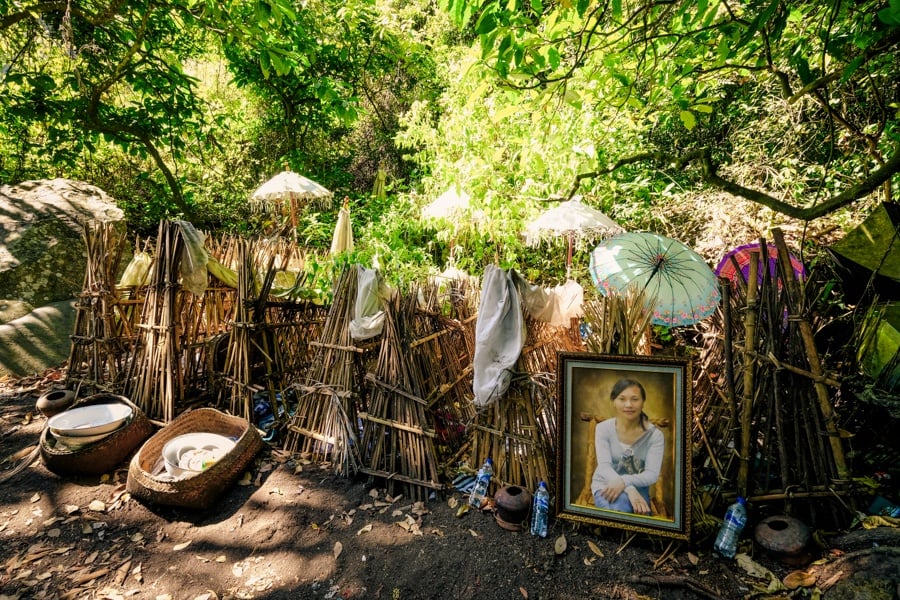
In Kintamani, there are traditional villages like Trunyan, Penelokan, Toya Bungkah, and Kintamani village. These places offer a peek into local Balinese life. Toya Bungkah, near Kintamani, has hot springs. Relaxing in these pools, surrounded by nature, is calming.
Trunyan is a Bali Aga village, one of the oldest on the island. You can reach it by a wooden boat from Kedisan or Toya Bungkah, a scenic ride. Trunyan is unique for its burial practices; instead of cremation, bodies decompose naturally in the Penglipuran Trunyan cemetery. Large taru menyan trees surround it, believed to neutralize the odor
The villages near Kintamani are famous for their arts and crafts. You can check out local markets for special handmade items like traditional textiles, wood carvings, and jewelry. Kintamani has a calm and peaceful vibe, making it perfect for people who want a quieter and more natural experience, away from the busy tourist spots in southern Bali.
Cons to visit Kintamani:
Weather Changes: Kintamani can get cooler due to its height, and the weather might be unpredictable, with sudden changes, rain, and mist. Be ready for different weather conditions.
Few Stay Options: Accommodations in Kintamani are limited compared to busier tourist spots. For more choices in hotels and amenities, consider staying elsewhere in Bali and visiting Kintamani for the day.
Quiet Evenings: Kintamani leans towards nature and culture, not vibrant nightlife. If you prefer a lively nightlife, you might want to look at other destinations.
Simple Dining: While there are places to eat, the food variety in Kintamani might not be as broad as in cities. Those with specific food preferences might find options limited.
High Altitude: Being at a higher elevation, Kintamani could affect some people with symptoms like headaches or dizziness. Stay hydrated and take it slow if you’re not used to higher altitudes.
Kintamani is a beautiful place with lots to see. It’s smart to plan ahead, know the conditions, and set realistic expectations before you go.
BULELENG
Buleleng is in northern Bali, about 80 kilometers (50 miles) north of Denpasar. You can reach it by road, and if you’re coming from the south, you’ll likely take the main road through Bedugul, which gives you beautiful views of the central highlands.
The region has beautiful natural sights, especially when driving from the south and passing through Bedugul. Located at a higher elevation, Bedugul offers a cooler climate than the coastal areas of Bali, making it a refreshing getaway from the lowland heat. One of Bali’s most famous temples, Ulun Danu Beratan Temple, sits on the shores of Lake Bratan in Bedugul, surrounded by scenic landscapes. The temple, dedicated to the goddess of the lake, has a unique floating appearance and is a must-see attraction. Bedugul also has the Bali Handara Kosaido Country Club, a golf course with a stunning mountain backdrop. Besides that, The Twin Lakes in the area are known for their scenic views, surrounded by greenery and hills, making them a popular spot for photographers, especially during sunrise or sunset.

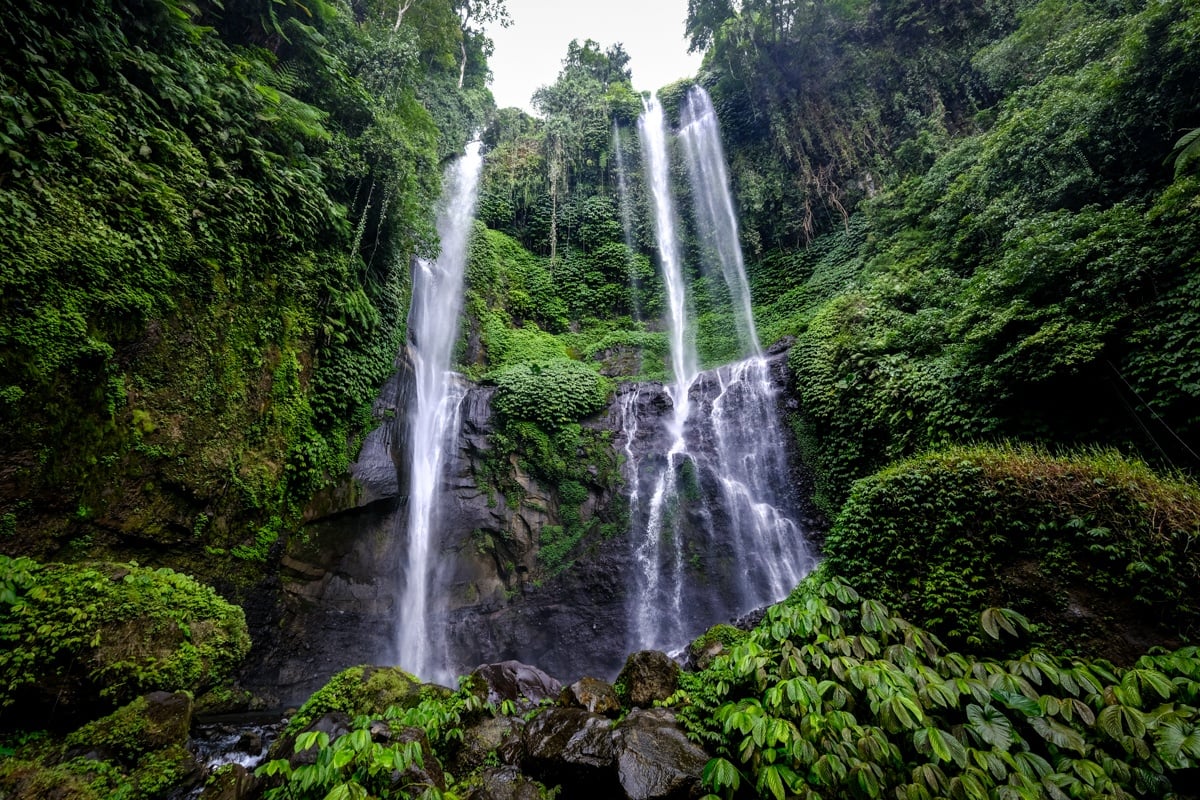
The trip to Bedugul is a beautiful drive through rice fields, mountains, and Balinese villages. The scenery is so nice that the journey itself is enjoyable. Nearby Munduk has lovely waterfalls like Munduk and Melanting, as well as Sekumpul, Gitgit and Aling-Aling. These waterfalls are in tropical landscapes with vibrant plants, creating a peaceful atmosphere in Bali’s highlands. Exploring them lets you escape into Bali’s less-known areas, offering chances for hiking and enjoying the refreshing waterfalls. The trek to the waterfalls is an adventure itself, passing through scenic landscapes.
When you get to Singaraja city, check out Lovina beach. It’s known for peaceful black sand beaches, a quieter vibe than the bustling south of Bali. Lovina is also a hotspot for dolphin watching—take a morning boat tour to catch them in action. Plus, there’s Banjar Hot Springs, natural springs in a lush garden setting. Relax in the warm, mineral-rich waters for a soothing experience.
Singaraja used to be Bali’s main city when the Dutch were in charge. It has old buildings from that time and places that tell the history, like the Gedong Kirtya Library with ancient manuscripts and the Beji Temple with a special style. Singaraja also has cultural spots and temples showing Balinese traditions. Don’t miss the lively local markets like Buleleng Market for fresh stuff, spices, and crafts to get a taste of Balinese life.
Singaraja in Bali is less crowded with tourists compared to the southern parts, offering a chance to explore the genuine local culture, connect with locals, and enjoy a peaceful and relaxed vibe.

Cons to visit Buleleng:
Weather: In northern Bali it’s often rainy from November to March, limiting outdoor activities.
Limited Nightlife: Singaraja lacks the lively nightlife found in places like Kuta or Seminyak.
Fewer Tourist Amenities: Compared to the south, Singaraja has fewer options for shopping, dining, and entertainment.
Distance from Attractions: Singaraja is far from popular spots like Airport and other tourist spots, so getting to Singaraja from there can take a while., requiring considerable travel time.
Whether you’re interested in natural beauty, cultural experiences, or a more relaxed beach atmosphere, Buleleng offers a diverse range of attractions that can appeal to a variety of travelers.
PEMUTERAN & WEST BALI NATIONAL PARK
Pemuteran is a quiet village on Bali’s northwest coast, known for its peaceful vibe and less crowded atmosphere compared to other tourist spots on the island. It’s famous for its coral reefs, making it a popular choice for diving and snorkeling. Nearby, you’ll find the West Bali National Park, Bali’s only national park, covering a large part of the island’s western tip. The park features diverse ecosystems like savannahs and mangrove forests, housing various wildlife, including the endangered Bali starling and wild cattle. Menjangan Island, within the park, is renowned for its pristine coral reefs, making it a favorite spot for diving and snorkeling. The park plays a crucial role in conserving Bali’s unique biodiversity.
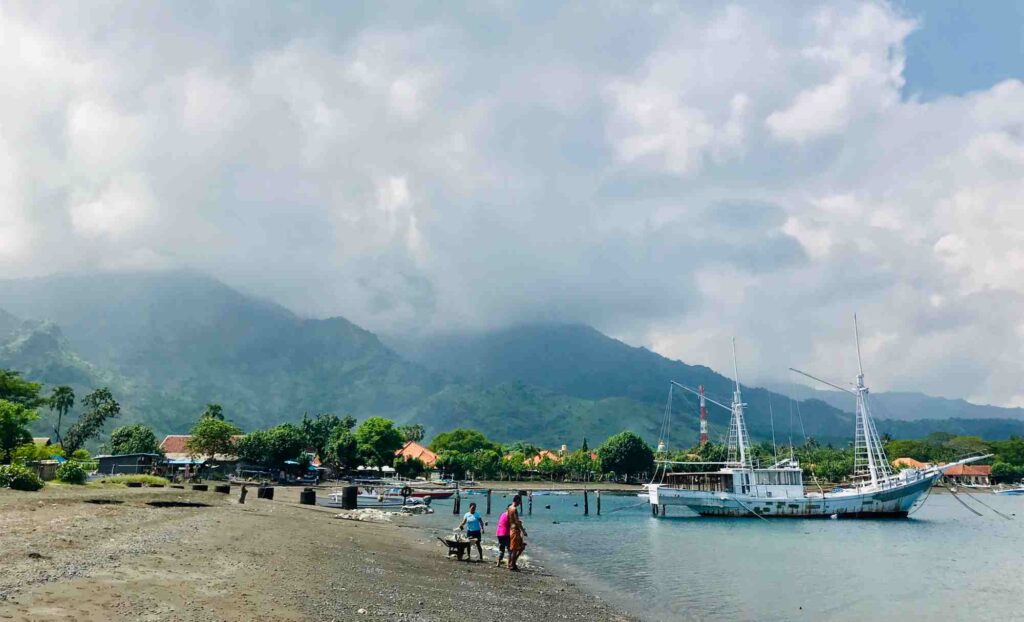
Pemuteran is famous for its beautiful coral reefs and clear waters, making it a great spot for diving and snorkeling. The coastal location of Pemuteran offers breathtaking sunsets over the Bali Sea, which you can enjoy from the beach or waterfront accommodations. In addition to its natural beauty, Pemuteran is a pioneer in community-based tourism and sustainable initiatives. The local community actively participates in coral reef restoration projects, making it an appealing destination for eco-conscious travelers interested in responsible tourism.
While Pemuteran is known for its natural attractions, there are also cultural sites to explore, such as temples and traditional Balinese villages. Engaging with the local culture can provide a more authentic and immersive travel experience.
One of the advantages of visiting Pemuteran is that it’s less crowded compared to some of Bali’s more popular destinations. This means you can enjoy a more relaxed atmosphere and have the opportunity to explore without the usual crowds.
Pemuteran is very close to West Bali National Park, which houses diverse ecosystems like mangrove forests, monsoon forests, and savannahs. It’s home to various plants and animals, including the endangered Bali starling, banteng, deer, and many bird species. Nature lovers will find it a rewarding environment.
Menjangan Island, part of the national park, is a popular spot for diving and snorkeling. Its coral reefs are famous for their health and beauty, with rich marine life and clear waters, perfect for underwater exploration and photography. The marine areas around Menjangan Island are known for crystal-clear waters and diverse marine life, featuring coral walls, caves, and vibrant gardens. Divers and snorkelers can encounter various fish, sea turtles, and fascinating marine creatures. The West Bali National Park actively works on conservation, especially for the Bali starling. Eco-tourism enthusiasts can learn about the park’s initiatives and contribute to responsible tourism practices.
The park has trekking paths to explore its different landscapes with a professional guide. West Bali National Park is quieter than other tourist spots in Bali, giving you a peaceful escape to connect with nature away from the busy crowds.

Cons to visit Pemuteran and West Bali National Park:
Remote location: Pemuteran and West Bali National Park are pretty secluded compared to the busier tourist spots in Bali. This quietness is great if you want peace, but not so much if you’re into lively nightlife or lots of dining choices.
Limited entertainment and shopping options: Pemuteran has fewer things to do and places to shop compared to other touristy spots in Bali. Also, if you love shopping for souvenirs, you might find the options here a bit limited.
Less developed infrastructure: Some parts of Pemuteran might not have as good infrastructure as the more popular places in Bali. This could affect stuff like transportation and internet access.
Limited public transportation: There might not be many public transportation options in Pemuteran, so you might have to rely on your own ride or rent a scooter to get around.
Wildlife encounter limitations: Even though West Bali National Park is known for its diverse wildlife, there’s no guarantee you’ll see any during your visit. If you’re really keen on wildlife, you might need a guided tour to up your chances.
If you want a place with beautiful nature, water fun, peace, and a bit of local culture, Pemuteran is great for your Bali trip. And if you love nature, adventure, and care about ecology and culture, West Bali National Park is perfect for you.
NUSA ISLANDS (LEMBONGAN-CENINGAN-PENIDA)
The Nusa Islands – Lembongan, Ceningan, and Penida – are to the southeast of Bali. Nusa Lembongan is the closest, about 12 km southeast of Bali. A 30-minute boat ride from Sanur takes you there. Nusa Ceningan is linked to Lembongan by a famous yellow bridge. Nusa Penida is farther away, requiring a 45-minute to an-hour boat ride from Sanur. However, it’s relatively close to Nusa Lembongan and Nusa Ceningan.
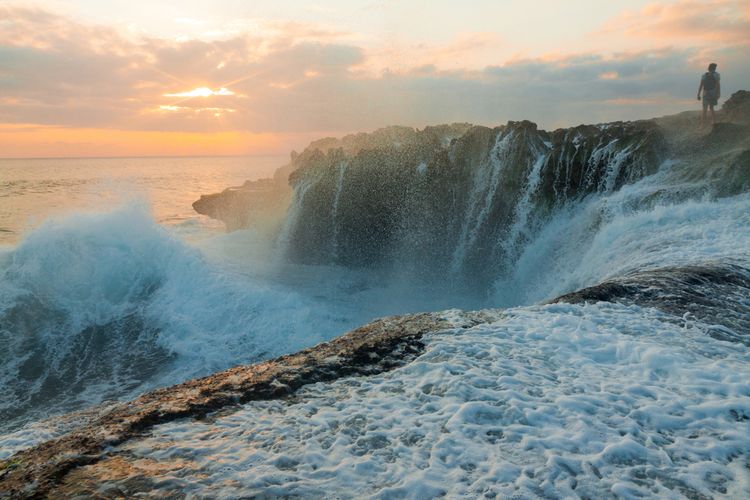
Nusa Lembongan and Ceningan have beautiful beaches with clear water and white sand. Jungut Batu and Mushroom Bay in Nusa Lembongan are great for relaxing and water activities. Devil’s Tear has impressive waves crashing on rocks, perfect for photos and enjoying nature’s beauty. Nusa Lembongan’s seaweed farms showcase traditional practices and contribute to the local economy.
The famous yellow bridge links Nusa Lembongan and Nusa Ceningan. Walking or scootering across it is not just a handy way to get around but also gives you beautiful views of the ocean. On Nusa Ceningan, you’ll find the Blue Lagoon, a gorgeous cliffside spot with amazing views of the turquoise waters. It’s perfect for taking stunning photos. If you’re into adventure, check out Ceningan Cliff, a popular spot for cliff-jumping with breathtaking views. It’s a thrilling experience for those seeking a bit of excitement.
Nusa Penida is famous for its stunning scenery, like cliffs, beaches, hills, and viewpoints. Must-see places include Kelingking Beach, Angel’s Billabong, and Broken Beach. Kelingking Beach, known as “T-Rex Bay,” has a unique T-Rex-shaped cliff and beautiful white sand, making it perfect for Instagram photos. Nusa Penida is also a top spot for diving, with Manta Point being famous for manta ray sightings. Divers and snorkelers can swim with these majestic creatures in their natural environment. There are plenty of other attractions to explore in Nusa Penida as well.
Nusa Islands are a chill escape from the busy parts of Bali. It’s perfect for a peaceful getaway. You can chill with friendly locals, dive into the local culture, and even catch traditional ceremonies.
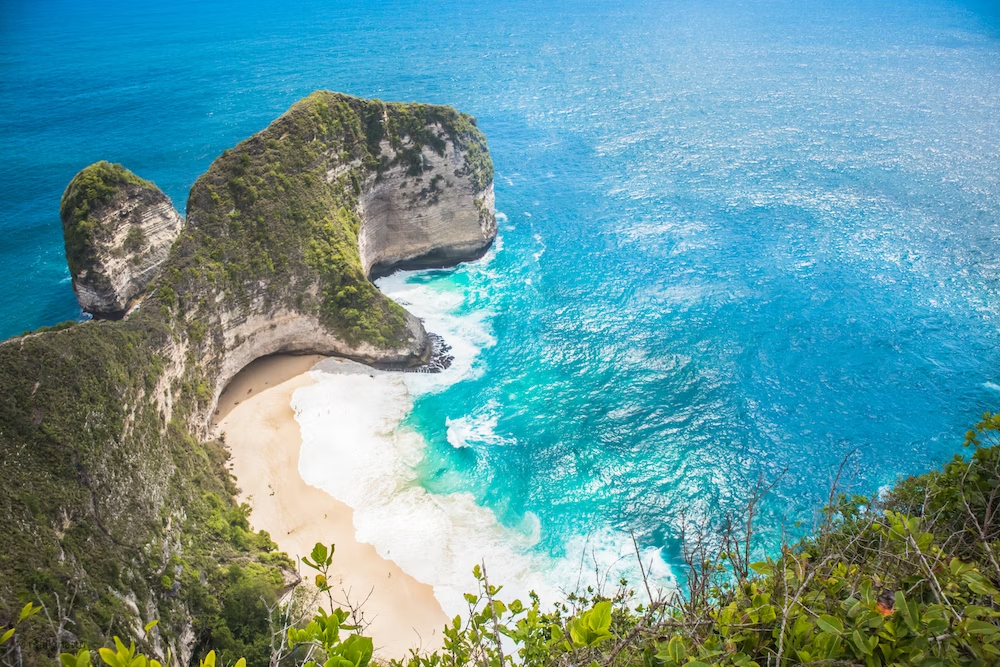
Cons to visit Nusa Islands:
Not much infrastructure: These islands may not have as many services like transportation and healthcare as fancier places do.
Bumpy boat rides: Going between Bali and the Nusa Islands can be a bit rocky, especially when it’s rainy. If you get seasick easily, it’s something to think about.
Quiet nightlife: If you’re into lively nightlife, these islands might not be the best pick. Things are generally more laid-back compared to other hotspots.
Kind of isolated: Some folks like the peace and quiet, but others might feel a bit lonely. The islands are small, and there might not be a ton of stuff to do.
Uneven development: The islands may not be evenly developed, and there can be disparities in the quality of accommodations, restaurants, and services.
Getting around isn’t a breeze: You can get to the islands by boat, but moving around once you’re there might be a bit tricky. Scooters are common, but the roads can be iffy.
Not crazy busy, but some spots get crowded: It’s not as jam-packed as other places in Bali, but the Nusa Islands, especially Nusa Penida, are getting more popular. At certain times, some attractions might be busy, but the rest is chill.
In short, Nusa islands have a great mix of nature, adventure, and culture, making them perfect for a memorable and relaxing getaway. Planning ahead and knowing what to expect will make your visit even more enjoyable.
TANAH LOT & KEDUNGU
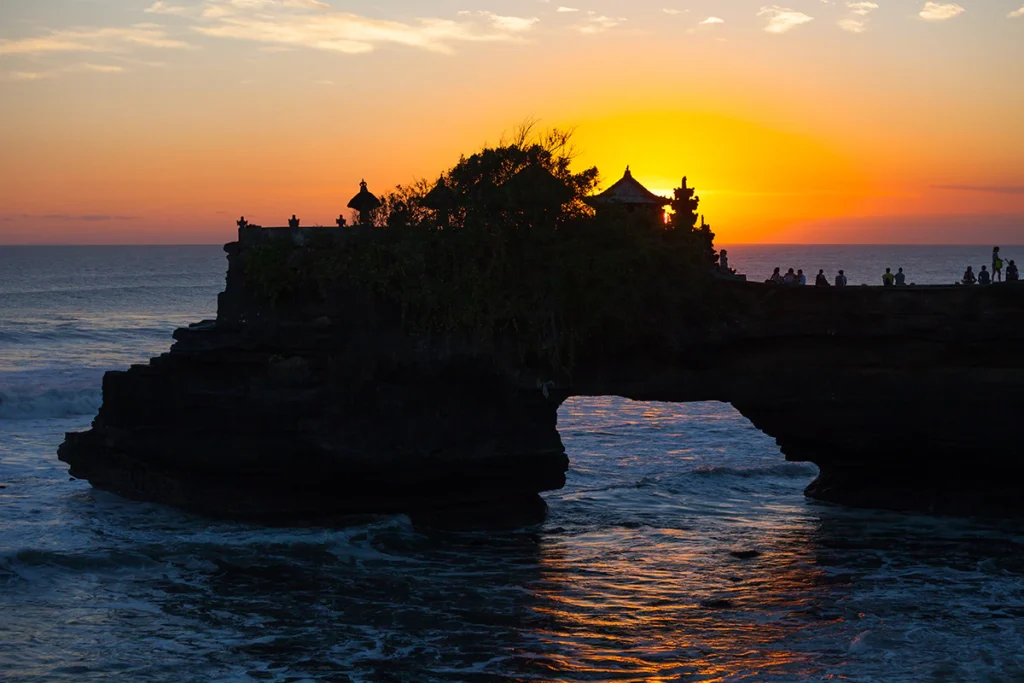
Tanah Lot and Kedungu are located on the southwest coast of Bali,and they are relatively close to each other. Tanah Lot is famous for its sea temple on a rock, offering breathtaking ocean views, especially at sunset. The temple is surrounded by water during high tide, creating a unique experience.
Tanah Lot is easy to reach by road and is close to popular tourist areas. The surroundings feature rugged coastlines, caves, and lush landscapes to explore, showcasing Bali’s natural beauty. The temple’s dramatic setting, especially at sunset, offers great photo opportunities with the changing sky colors and ocean backdrop. Beyond being a tourist spot, Tanah Lot holds cultural and spiritual importance for the Balinese people as part of a series of sea temples along the southwest coast. In the area, you’ll find plenty of restaurants and stalls selling food and souvenirs.
Kedungu, near Tanah Lot, is a beautiful beach with black sand and a pristine coastline. Surrounded by greenery, it’s a peaceful escape from busy tourist spots. Popular among surfers for its uncrowded waves, Kedungu suits all skill levels. Enjoy stunning sunset views over the Indian Ocean and a serene evening stroll. Inland, discover expansive rice fields in Tabanan, offering a contrast to the coastal scenery. Less crowded than famous Bali beaches, Kedungu provides a quieter, authentic experience for those seeking solitude and relaxation.
After Canggu developed, many people are now heading north to explore places like Seseh Beach, Nyanyi Beach, and Kedungu Beach. These areas are undergoing development with new villas and amenities.

Cons to visit Tanah Lot and Kedungu
Crowd: Tanah Lot, especially, is super famous, so lots of people go there, especially when it’s the busiest time for tourists.
Changing a Lot: After Canggu got popular, now people are going up north to check out places like Seseh Beach, Nyanyi Beach, and Kedungu Beach. They’re building new stuff there, like houses and things. Some people might not like that because it takes away from the natural or cultural feel.
High-tide conditions: Tanah Lot is a temple in the sea, and when the tide is high, it gets surrounded by water. It looks really nice, but sometimes you can’t get up close to it during certain parts of the day.
Limited Facilities: In some far-off places like Kedungu, there aren’t many things like restaurants or bathrooms. If you plan to stay there a long time, be ready for that.
While Tanah Lot is undoubtedly a popular and visually stunning destination, it’s essential to be mindful of the potential crowds. Additionally, checking the tide schedule can enhance your experience by allowing you to see the temple in different states—either surrounded by water during high tide or accessible by foot during low tide. While Kedungu may not be as well-known as some of Bali’s more famous beaches, it appeals to those seeking a more tranquil and less touristy experience. As always, it’s advisable to check current conditions and local recommendations before planning your visit.
MEDEWI

Medewi is a village on Bali’s west coast, in Jembrana district. It’s quite far from Denpasar, Bali’s capital. Getting to Medewi by car takes a few hours on winding roads.
Medewi is famous for its long, left-hand wave and black sand beach, attracting surfers looking for a quieter and more laid-back experience than other popular spots in Bali. If you prefer a peaceful and calm atmosphere away from the busy tourist areas, Medewi offers a serene setting with rural landscapes, including rice paddies and coconut groves. The natural beauty of Medewi, with its greenery, coastal views, and breathtaking sunsets, makes it perfect for nature lovers and photographers who appreciate a more unspoiled environment.
Medewi lets you see how people in a Balinese village live. You can enjoy the local culture, talk to friendly locals, and see traditional ceremonies. The welcoming atmosphere makes it easy for visitors to connect with the community.
cons to visit Medewi:
Few Things to Do at Night: Medewi is a quiet, rural spot, so if you’re into lively nightlife and lots of entertainment, you might be a bit bored here compared to busier places in Bali.
A Bit Out of the Way: Medewi is a tad remote, especially if you’re coming from the more popular parts of Bali. The journey might be long, and the roads might not be in the best shape.
Not Many Places to Eat: There are local eateries, but if you’re a foodie looking for lots of different dining options, Medewi might not have as much to offer as busier tourist spots.
Basic Infrastructure: Medewi isn’t as developed as other touristy places in Bali, so things like reliable internet, ATMs, and medical facilities might be a bit limited. It’s good to be ready for that and plan accordingly.
Surfing Depends on the Season: Medewi is famous for surfing, but the waves can be seasonal. It’s important to check the surf forecast before planning your trip, especially if surfing is a big part of your plans.
Not Much for Shopping: If you love shopping for souvenirs or exploring markets, you might find fewer opportunities in Medewi compared to more touristy areas.
While Medewi may not have the same level of amenities and infrastructure as more developed tourist areas in Bali, its unique charm lies in its simplicity and authenticity. If you’re seeking a more off-the-beaten-path experience and have an interest in surfing or exploring traditional Balinese culture, Medewi could be a memorable destination for your travels.
Ultimately, the type of Bali experience you have—whether it’s a luxurious getaway, a budget-friendly trip, a nature and adventure excursion, a tranquil retreat, or a lively party—depends on your preferences. Bali caters to all kinds of travellers from around the world, offering a variety of options for everyone.

